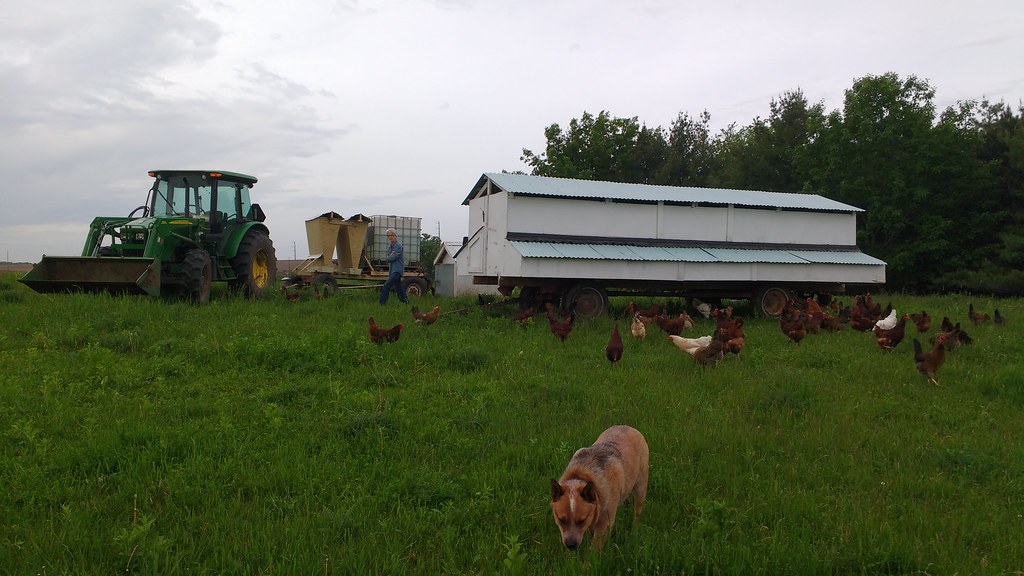Aside from the color variations of the shells, most people who try our eggs notice their bright yellow yolk and rich taste. This is due to our chickens being out on pasture as much as possible.
(Our eggs on the left, other nameless “free range” eggs on the right.)
Additionally, studies have shown the superior nutrition of eggs from chickens raised on pasture. Mother Earth News conducted such studies and here is what they found. Compared to commercially raised eggs, pastured eggs contained:
• 1/3 less cholesterol
• 1/4 less saturated fat
• 2/3 more vitamin A
• 2 times more omega-3 fatty acids
• 3 times more vitamin E
• 7 times more beta carotene
And 4 to 6 times more Vitamin D
To maximize our ability to keep our hens on pasture, Andrew designed and built what we call the “Winnebeggo”.
Winnebeggo on the right, me and Chuckwagon in the middle. Bullit in the foreground.
This is a mobile home for the chickens where they live from the time pasture first appears in the spring until their water starts freezing in the fall. The Winnebeggo has nest boxes in which the chickens lay their eggs and roost bars where they roost at night, allowing us to lock them up and keep them safe from night time predators. It has no lounging area which forces the chickens to do their lounging out on the pasture, thereby encouraging them to eat more bugs and grass. This is what produces the bright yellow yolk color and rich flavor.
I have seen firsthand, farms who call their eggs pasture raised where chickens roamed around in a single fenced dirt paddock. In all fairness, those paddocks may have been grass in the beginning, but a chicken’s natural behavior is to scratch the ground and they can turn a grass paddock into a dirt paddock very quickly. If you buy your eggs elsewhere, be sure to ask if the hens are on actual pasture or in a dirt yard.
We move the Winnebeggo once every two days to a fresh piece of pasture. It is moved so often is because the floor of the Winnebeggo, under the roost bars, is a wire floor, which allows chicken manure to fall through to the ground below. When chickens wake up in the morning, the first thing they do, before moving from the roost is…..you guessed it, poop. If we allowed that manure to build up on the ground for more than a couple of days, the concentration of fertilizer would burn up our pasture. By moving them regularly, we spread natural fertilizer on our pasture and have no chicken house to clean out. Win – Win!
Chickens cannot survive on pasture alone, so they are provided free choice feed while out on pasture. Because we keep the Winnebeggo far away from the barn and the food and water sources, Andrew devised what he calls the “Chuckwagon”, a mobile food and water system.
Once the chickens’ water starts freezing in the fall, and the pastures become dormant, we are forced to move the girls into their conventional chicken house. They are still allowed unlimited access to the outdoors during the day and locked up at night.
Because we believe in the value of the chickens eating green stuff all year, last winter I started growing barley fodder to feed once they were moved to the chicken house. Fodder is made by sprouting and growing seed indoors under grow lights. We sprout non-GMO barley we grew on out farm last year. Producing enough fodder for 400 plus chickens is very labor intensive, but I must admit it is fun seeing how much the chickens enjoy seeing me arrive in the morning with their winter “pasture”. They flock” to me. (Sorry, couldn’t resist.)
This photo shows fodder about half way through the growing process. Once it is ready to feed, the growth looks like a thick lush carpet of barley grass. The chickens also eat barley unsprouted, free choice year round in addition to their regular feed.
Up next: Part 3: Chicken Behavior and Other Miscellany




Very interesting, I am wondering what you do in your spare time 🙂 and where you are going to put all those chickens this winter? Will your barn hold them?